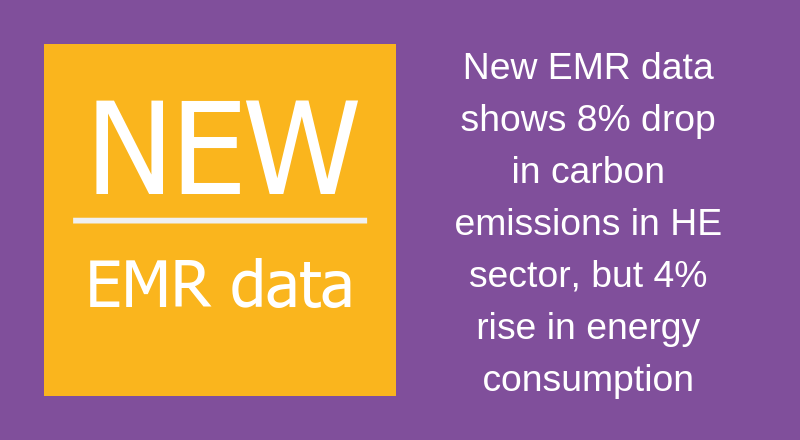This data should be a wakeup call to Vice-Chancellors that think the HE sector is doing enough to help combat Climate Change.
Environmental statistics (EMR data) released last week revealed an 8% fall in carbon emissions by HE providers despite a 4% increase in energy consumption.
In 2017/18 HE providers in England, Wales and Northern Ireland consumed 6.7 Terawatt hours of energy, compared to 6.5 Terawatt hours in 2016/17. Carbon dioxide emissions fell from 1.7 million tonnes to 1.6 million tonnes over the same period.
The figures come from environmental information published by HESA from the annual Estates Management Record. The record is optional for universities in Scotland to return, and some items are optional for all UK HE providers.
HE provider level statistics include the area of universities’ buildings and grounds, renewable energy generation, water consumption, emissions, waste, recycling, transport, and environmental management.
|
HE in statistics |
|||
|
|
2016/17 |
2017/18 |
Up/Down |
|
Total number of buildings |
15951 |
16250 |
Up 1.8% |
|
Total site area (hectares) |
14841 |
11307 |
Down 23% (but fewer reported this statistic in 2017/18) |
|
Total energy consumption (KwH) |
7,547,513,736.20 |
7,802,295,083.96 |
Up 3.3% |
|
Total generation of electricity exported to the grid (KwH) |
1995994.4 |
3235407.07 |
Up 62% |
|
Total fuel used in HE provider owned vehicles (litres) |
4,871,412.72 |
5,260,472.34 |
Up 7.9% |
|
Total renewable energy generated onsite or offsite (kWh) |
43,587,442.39 |
40,952,423.62 |
Down 6% |
|
Total water consumption (m3) |
25,183,337.15 |
24,945,798.62 |
Down 1% |
|
Total volume of waste water (m3) |
24,010,403.73 |
22,841,127.75 |
Down 4.8% |
|
Total scope 1 and 2 carbon emissions (Kg CO2e) |
1,949,718,114.60 |
1782203858 |
Down 8.6% |
|
Total waste mass (tonnes) |
540484.387 |
416081.701 |
Down 23% |
Iain Patton, CEO at EAUC, said:
“We are pleased to see carbon emissions falling in the HE sector, this is an agenda that desperately needs to be tackled and it is good that universities are taking this seriously. As ever though, more can and should be done. The EAUC has declared a Climate Emergency, and we are encouraging institutions to now commit to reaching net zero emissions as soon as possible. We hope to see a far bigger drop in carbon emissions in the next set of EMR data.
“We are disappointed to see the rise in energy consumption in the HE sector, but we are keen to explore the reasons behind this with our membership and support them to make changes to rectify this situation. Many institutions have taken steps to diminish their energy consumption in diverse and innovative ways and we hope the sector will show the leadership it is capable of on this topic.
“This data should be a wakeup call to Vice-Chancellors that think the HE sector is doing enough to help combat Climate Change. There is much more to do, and as educators of the next generation of change makers, and occupiers of large geographical spaces, university leaders need to show young people they are willing to fight to ensure their future is not marred by their inaction.”
Environmental information is published as open data, freely available for re-use under a Creative Commons 4.0 licence. Data tables in the release include three years of data, with older data back to 2008/09 free to download from HESA’s publication archive.











